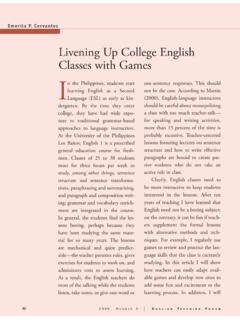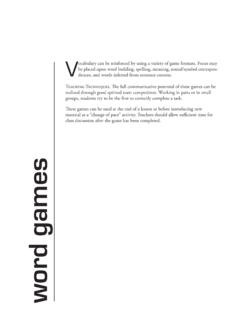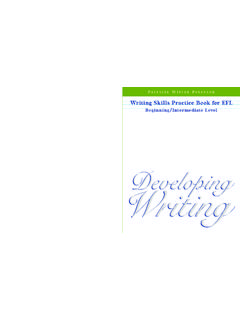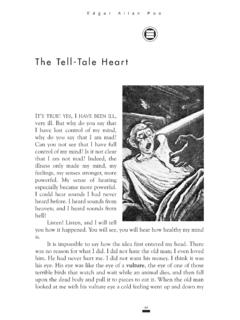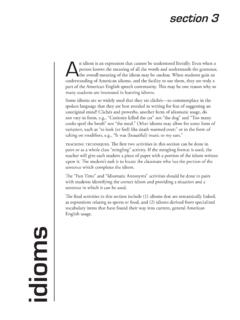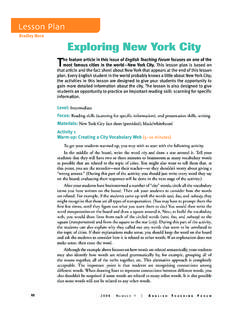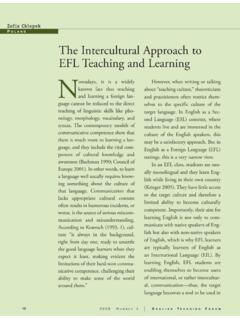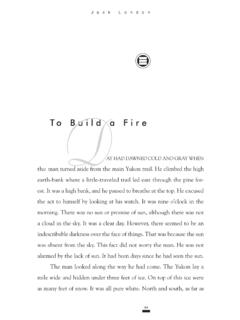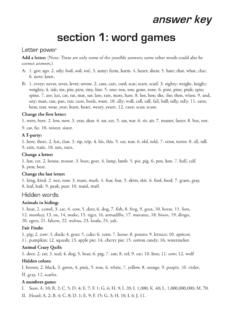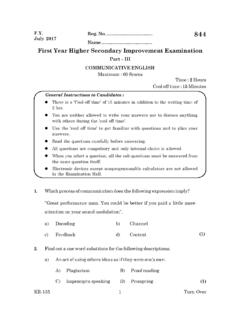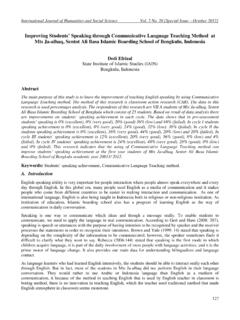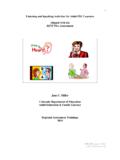Transcription of The Relevance of Literary Analysis to Teaching …
1 22 0 0 9 Nu m b e r 3 | En g l i s h TE a c h i n g Fo r u mT r u o n g T h i M y Va nThe Relevance of Literary Analysis to Teaching literature in the EFL ClassroomFor many university teachers of English as a foreign language (EFL), the study of literature is indispensable because it exposes students to meaningful contexts that are replete with descriptive language and interesting characters. Structur-ing lessons around the reading of literature introduces a profound range of vocabulary, dialogues, and prose. In addition to developing students English language skills, Teaching lit-erature also appeals to their imagina-tion, develops cultural awareness, and encourages critical thinking about plots, themes, and characters.
2 Most importantly, the activities that one can apply with literature lessons easily conform to the student-centered and interactive tenets of Communicative Language Teaching (CLT).Unfortunately, many postgradu-ate EFL teacher-training courses focus mainly on language Teaching method-ology and offer little guidance on the analytical methods that are essential to interpreting literature and design-ing effective classroom activities. This means that both the students and teachers lose out. Fortunately, there are a variety of resources for instruc-tors to use to improve their classes with the study of article presents a basic review of six approaches to Teaching litera-ture and includes a discussion based on my own experience as well as feed-back from colleagues who are famil-iar with the different approaches.
3 Although this discussion pertains to the university-level EFL context in Vietnam, it can be generalized to the wider global audience of instructors of English for Speakers of Other Lan-guages (ESOL). A review of six approaches to Literary analysisBecause the field of Literary analy-sis of fiction, drama, and poetry has a long history, many theories exist on how to evaluate and teach literature . Six frequently discussed approaches to Literary Analysis include: (1) New Crit-icism, (2) Structuralism, (3) Stylistics, 3En g l i s h TE a c h i n g Fo r u m | Nu m b e r 3 2 0 0 9(4) Reader-Response, (5) Language-Based, and (6) Critical Literacy. The sections that follow will briefly introduce these six approaches and discuss the benefits and drawbacks they offer for Teaching literature in the EFL classroom.
4 Approach 1: New Criticism The New Criticism approach to Literary Analysis appeared in the United States after World War I. According to this theory, mean-ing is contained solely within the Literary text, apart from the effect on the reader or the author s intention, and external elements are disregarded when analyzing the work. The reader s role is to discover the one correct meaning by a close reading and Analysis of for-mal elements such as rhyme, meter, imagery, and theme. According to Thomson (1992), the world of a Literary work is self-contained, and readers must exercise total objectivity in interpreting the text. In other words, the social, historical, and political background of the text, as well as the reader s reactions or knowledge of the author s intention, distract from and are not relevant to the interpretation of the Literary of the New Criticism approachThe major drawback of New Criticism is that most class activities are dedicated to iden-tifying formal elements and Literary devices such as symbolism, metaphors, similes, and irony.
5 This turns the study of Literary terms into an end in itself rather than a means to discover the beauty and value of a Literary work. This excludes looking at the connection between the text and the reader s experiences and the historical and sociolinguistic influ-ences that become apparent during the read-ing process (Thomson 1992).Some who criticize the approach feel that readers inevitably relate to aspects of what they are reading and become subjectively involved with the text. In fact, this is why many teach-ers choose particular texts and communicative Teaching methods: to treat reading as a process that requires introducing content; describ-ing the setting, characters, and plot; relating the text to students experience; and eliciting student opinion and discussion.
6 This can, of course, include the study of Literary terms, but it does not make that technique an end in itself but rather a means to discover the beauty and value of a Literary work. The feedback I received from my teacher colleagues about this approach included the following responses: Different people have different responses; for example, you cannot force me to respond like you, and vice versa. literature concerns the soul. Each per-son has a distinctive soul that cannot be totally identical. These teachers also felt that without a subjective response to the meaning of the text, and with the heavy dependence on the teacher to decipher the Literary work, students will not progress in building their language skills.
7 Therefore, the application of the New Criti-cism approach offers students little enjoyment or recognition of the value of literature , and perhaps worse, creates a negative attitude towards selection of Literary textsOne criticism of using literature in the EFL classroom deals with the overuse of what is called the traditional canon those famous, classic, award-winning Literary works that often contain language that is difficult for a learner of English to comprehend. As one o f my colleagues noted, It is very hard to criticize and understand the deeper meanings of those famous works that have won many prizes. This issue especially relates to New Criticism, which typically deals with texts that exemplify the highest Literary values.
8 Because this single-minded focus neglects the read-ers experience, there is little reason to select texts that are suitable to the learners needs or language proficiency. Although not all Literary classics are too difficult for EFL classes, the point for teachers is that they should consider literature that students can access and relate choosing acceptable texts for the EFL context, there are several things to consider. First is the difficulty of the vocabulary and syntax, and teachers should look for works that match the level they are Teaching . Other things that make literature difficult are the historical, social, and political references that add complexity for non-English speakers.
9 The students cultural unfamiliarity with texts causes problems and makes the students dependent on the teacher s interpretation. As a result, students often have to study literature by listening to the teacher s translation and 42 0 0 9 Nu m b e r 3 | En g l i s h TE a c h i n g Fo r u mwriting down aspects of the Analysis . The teacher, who speaks mostly in the students native language, monopolizes a large part of the classroom time, which is an unproductive way to learn combination of difficult language and cultural material creates passive students and negatively affects their motivation due to the lack of enjoyment or benefit from the experi-ence.
10 An American teacher with experience in Teaching literature in Vietnam correctly sum-marized the type of texts used with the New Criticism approach: They are too long, too linguistically difficult, too culturally or his-torically unfamiliar, and have few or no points of connection with students lives. Approach 2: StructuralismStructuralism is an approach that gained importance in the 1950s; instead of interpret-ing a Literary text as an individual entity, this approach determines where a Literary text fits into a system of frameworks that can be applied to all literature (Dias and Hayhoe 1988). Like New Criticism, Structuralism emphasizes total objectivity in examining Literary texts and denies the role of readers personal responses in analyzing literature .
